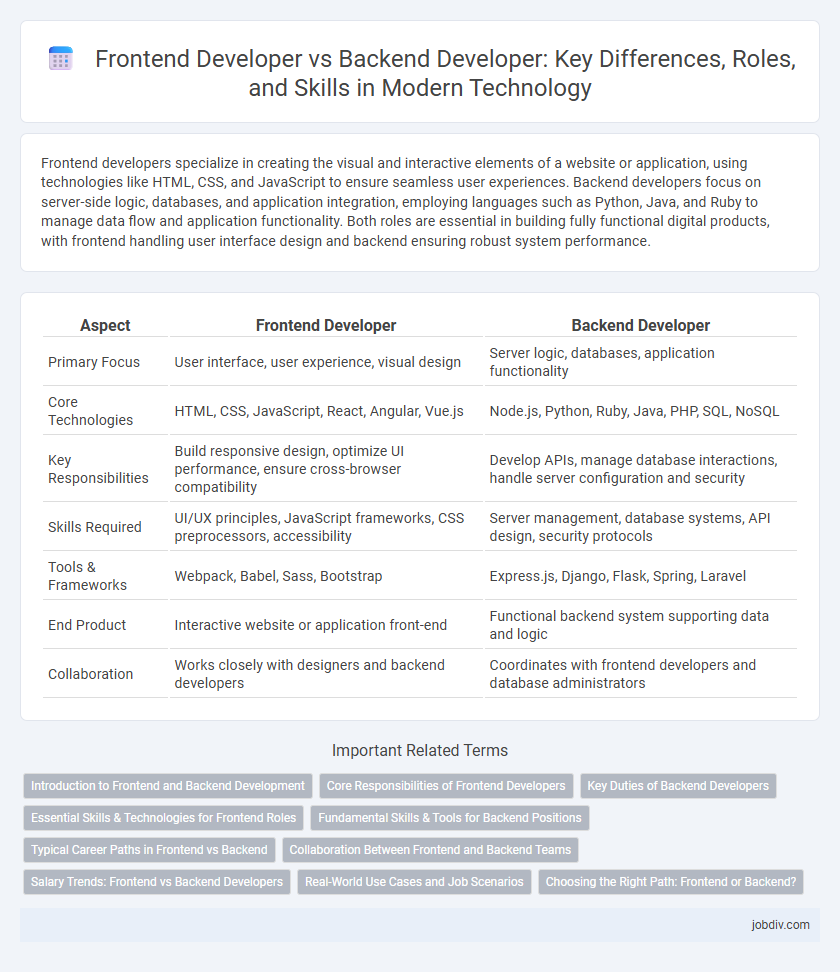Frontend developers specialize in creating the visual and interactive elements of a website or application, using technologies like HTML, CSS, and JavaScript to ensure seamless user experiences. Backend developers focus on server-side logic, databases, and application integration, employing languages such as Python, Java, and Ruby to manage data flow and application functionality. Both roles are essential in building fully functional digital products, with frontend handling user interface design and backend ensuring robust system performance.
Table of Comparison
| Aspect | Frontend Developer | Backend Developer |
|---|---|---|
| Primary Focus | User interface, user experience, visual design | Server logic, databases, application functionality |
| Core Technologies | HTML, CSS, JavaScript, React, Angular, Vue.js | Node.js, Python, Ruby, Java, PHP, SQL, NoSQL |
| Key Responsibilities | Build responsive design, optimize UI performance, ensure cross-browser compatibility | Develop APIs, manage database interactions, handle server configuration and security |
| Skills Required | UI/UX principles, JavaScript frameworks, CSS preprocessors, accessibility | Server management, database systems, API design, security protocols |
| Tools & Frameworks | Webpack, Babel, Sass, Bootstrap | Express.js, Django, Flask, Spring, Laravel |
| End Product | Interactive website or application front-end | Functional backend system supporting data and logic |
| Collaboration | Works closely with designers and backend developers | Coordinates with frontend developers and database administrators |
Introduction to Frontend and Backend Development
Frontend development involves creating the visual components and user interfaces of websites or applications using technologies like HTML, CSS, and JavaScript. Backend development focuses on server-side logic, databases, and application functionality using languages such as Python, Java, or Node.js. Both roles collaborate to deliver a seamless digital experience by integrating client-side interactions with server-side processes.
Core Responsibilities of Frontend Developers
Frontend developers specialize in creating the visual elements and interactive user interfaces of websites and applications using HTML, CSS, and JavaScript frameworks like React or Angular. They ensure responsive design, optimize user experience, and handle cross-browser compatibility. Their core responsibilities include translating design mockups into functional components, implementing client-side logic, and enhancing application performance.
Key Duties of Backend Developers
Backend developers design and maintain server-side logic, databases, and application programming interfaces (APIs) to ensure seamless data flow and functionality. They implement security protocols, optimize application performance, manage server, database integration, and handle authentication processes. Expertise in server-side languages like Python, Node.js, Java, and frameworks such as Express or Spring is essential for backend development roles.
Essential Skills & Technologies for Frontend Roles
Frontend developers excel in HTML, CSS, and JavaScript, leveraging frameworks like React, Angular, or Vue.js to build dynamic user interfaces. Proficiency in responsive design, cross-browser compatibility, and performance optimization ensures seamless user experiences across devices. Familiarity with version control systems like Git, as well as basic knowledge of RESTful APIs and AJAX, enhances collaboration and frontend-backend integration efficiency.
Fundamental Skills & Tools for Backend Positions
Backend developers require strong proficiency in server-side languages such as Python, Java, and Node.js, alongside database management systems like MySQL, PostgreSQL, and MongoDB. Mastery of RESTful APIs, authentication protocols, and cloud platforms such as AWS or Azure is essential for scalable and secure backend services. Knowledge of version control tools like Git and familiarity with containerization technologies like Docker further enhance backend development efficiency and deployment.
Typical Career Paths in Frontend vs Backend
Frontend developers often begin as junior UI/UX coders, progressing to roles focused on JavaScript frameworks like React or Angular, and may advance to lead frontend architect or product designer positions. Backend developers usually start with server-side programming languages such as Python, Java, or Node.js, moving towards database management, API development, and ultimately becoming backend engineers or system architects. Both career paths offer opportunities to transition into full-stack roles or specialize in DevOps, cloud infrastructure, or software engineering management.
Collaboration Between Frontend and Backend Teams
Frontend and backend teams collaborate closely to ensure seamless user experiences by integrating UI components with server-side logic and databases. Effective communication between these teams allows for synchronized API development, faster troubleshooting, and optimized performance across platforms. Leveraging tools like RESTful APIs, GraphQL, and version control systems enhances this collaboration, driving efficient project delivery and robust application architecture.
Salary Trends: Frontend vs Backend Developers
Frontend developers typically earn competitive salaries driven by demand for user interface expertise, with average annual earnings ranging from $70,000 to $110,000 depending on location and experience. Backend developers often command higher salaries, averaging between $80,000 and $130,000, due to specialized skills in server, database management, and API development. Salary trends indicate a growing parity as full-stack development gains popularity, but backend roles generally maintain a premium because of complexity and critical system responsibilities.
Real-World Use Cases and Job Scenarios
Frontend developers specialize in creating intuitive user interfaces using technologies like HTML, CSS, and JavaScript, optimizing the user experience in applications such as e-commerce websites and mobile apps. Backend developers manage server-side logic, databases, and APIs, ensuring robust performance and data integrity for platforms like content management systems and financial services. Real-world job scenarios often require frontend developers to focus on responsive design and accessibility, while backend developers concentrate on server infrastructure, security, and data processing.
Choosing the Right Path: Frontend or Backend?
Choosing between frontend and backend development hinges on your interest in user experience versus server-side logic. Frontend developers specialize in creating interactive, visually appealing interfaces using HTML, CSS, and JavaScript frameworks like React or Angular. Backend developers focus on databases, server management, and application logic with languages such as Python, Java, or Node.js, ensuring data processing and security are robust and efficient.
Frontend Developer vs Backend Developer Infographic

 jobdiv.com
jobdiv.com